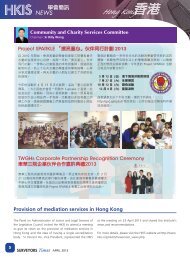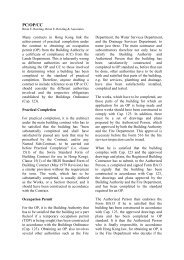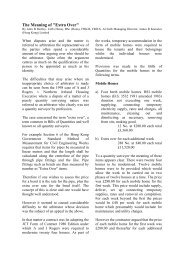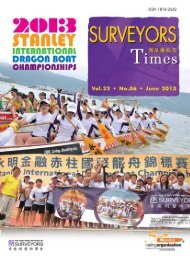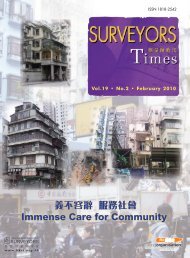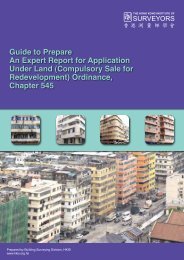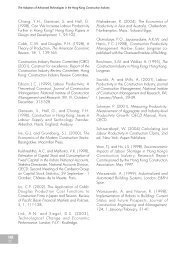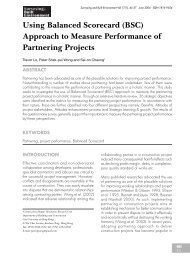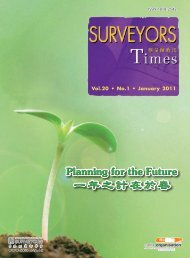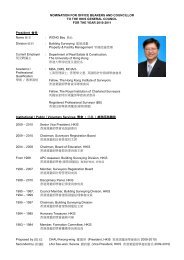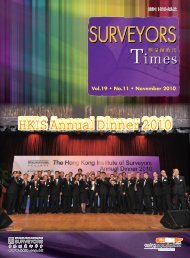Surveying & Built Environment Vol. 22 Issue 1 (December 2012)
Surveying & Built Environment Vol. 22 Issue 1 (December 2012)
Surveying & Built Environment Vol. 22 Issue 1 (December 2012)
You also want an ePaper? Increase the reach of your titles
YUMPU automatically turns print PDFs into web optimized ePapers that Google loves.
SBE<br />
6<br />
documents (Hong Kong Special Administrative Region <strong>2012</strong>) like C11 (Sandy Bay<br />
– Telegraph Bay in the past), D7 (Tai Ham Harbour), and C131 (the beautiful rocky<br />
coast of Devil’s Peak (now confusingly called Pau Toi 1 Shan) in Junk Bay (now<br />
called Tseung Kwan O) in the government’s recent proposal are even worse, as<br />
they are not even straight, but create bulges in existing artificial or natural coasts.<br />
C11 and C131 are the most disastrous in terms of the overall urban imaging of<br />
Victoria Harbour, as they would very likely mess up further the settings to the<br />
western and eastern maritime approaches to the harbour. The backdrop of C11<br />
is Mount Davis-Kennedy Town Gap-High West, while that for C131 is Devil’s<br />
Peak. Both “options,” given current land economic logic, would mean the piling<br />
up of residential blocks that break the ridge lines and hardly add any scenic or<br />
cultural value to existing visual settings. C131 ignores the past decision of the<br />
government’s engineers to abandon a coastal road from Lee Yue Mun to Tseung<br />
Kwan O New Town to save the rocky coast. D7 is also a bad idea, as the disused<br />
quarry site is large enough for recreational or non-residential purposes: Shek O<br />
and Tai Tam Road (especially the section along the narrow top of the main dam<br />
of Tai Tam Tuk Reservoir) would not be able to cope with another Red Hill-type<br />
residential development without widening or tunneling work, which would likely<br />
destroy the WWII pillboxes and bunkers at Tai Tam Gap as well as irredeemably<br />
blight one of the few landscapes penetrated by roads that still are fringed by<br />
relatively unengineered natural slopes.<br />
What Hong Kong needs is the planning and development of manmade offshore<br />
islands of significant scale with their own CBD and functional areas rather than adhoc<br />
reclamations added to existing coastal lines. This strategy can integrate with<br />
ecological compensatory endeavours and cope with long term development.<br />
Hong Kong Island and the land mass across the Victoria Harbour have already been<br />
over-saturated with urban development through reclamations and hill terracing.<br />
Also, the carefully planned options of Metroplan have been stopped by the<br />
Protection of the Harbour Ordinance. The alternative, therefore, must be a major<br />
new urban area away from any existing shoreline intelligently sited to minimize<br />
adverse effects on both summer and winter monsoon tide and current flows, whilst<br />
equally minimally impacting the already severely compromised natural outlines of<br />
the islands from Tung Lung to the Sokos, and protecting the undamaged beauties of<br />
the waters to the east. Shall we call it Utopia?<br />
1 “Pau Toi” literally means “batteries”. Hills like Mount Davis have remains of batteries and so this<br />
name for Devil’s Peak is not ideal, bearing in mind also that the Chinese name of Fortress Hill Road,<br />
North Point, is also called “Pau Toi Shan” because there was once a battery there too.



